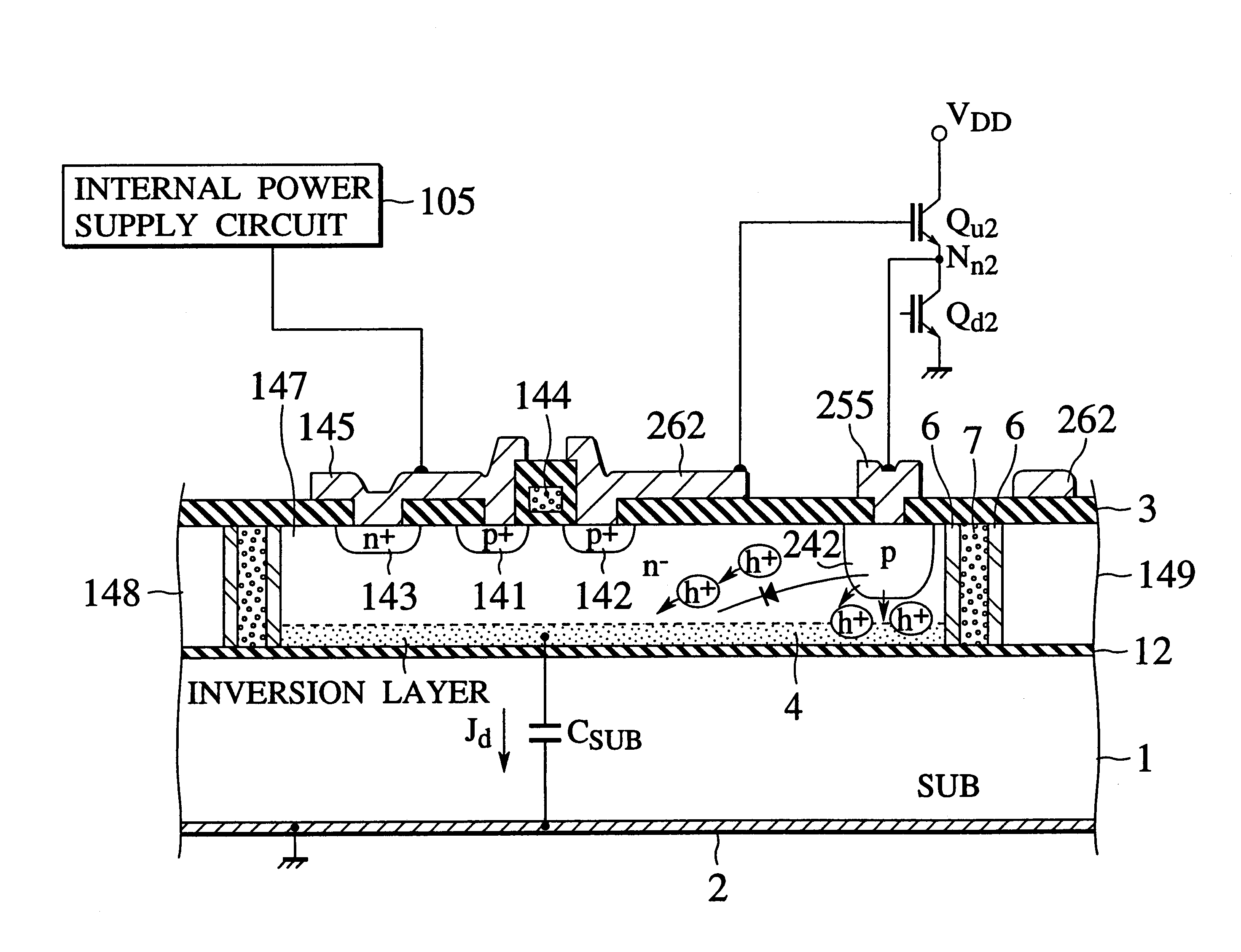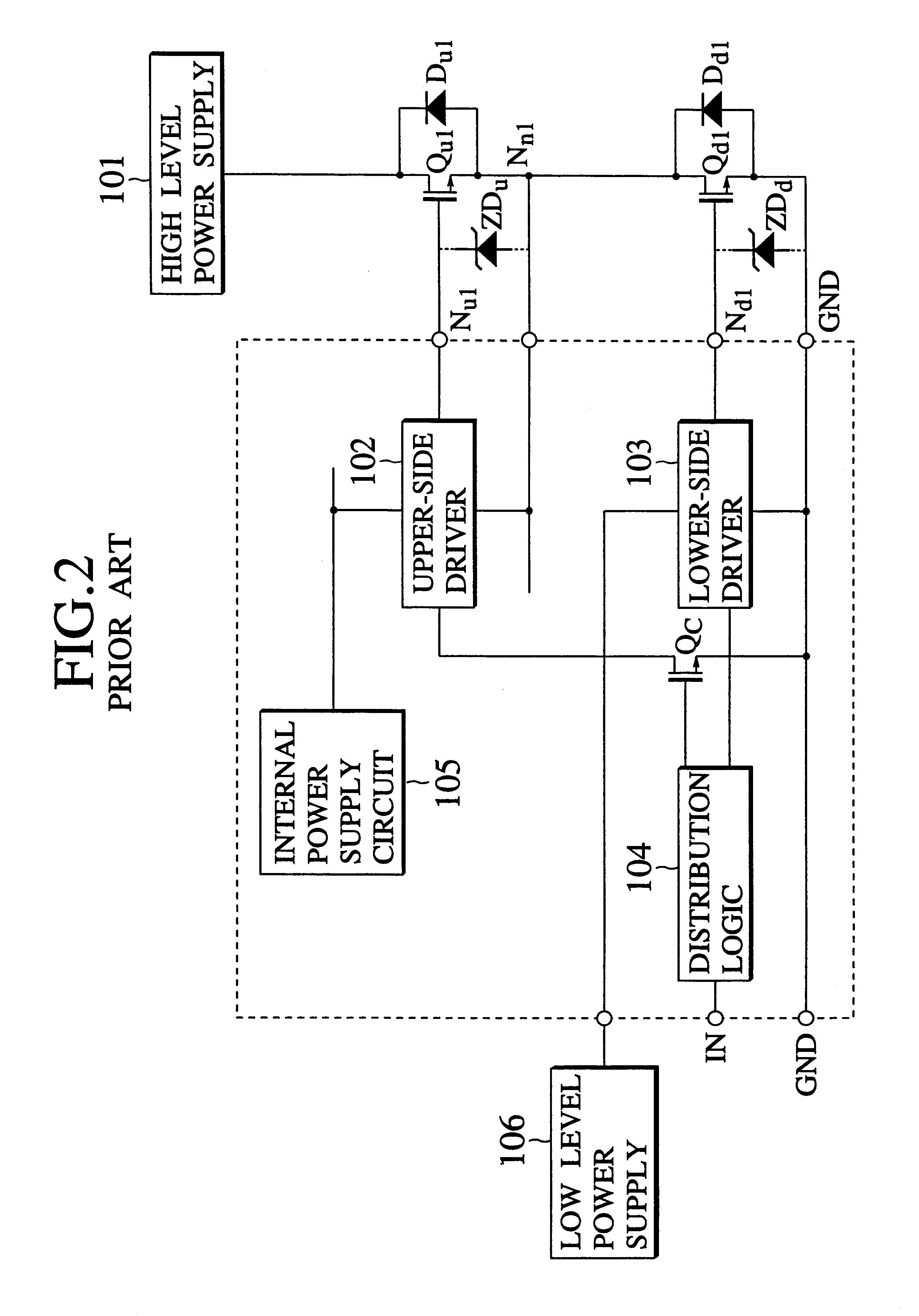Dielectrically isolated IC driver having upper-side and lower-side arm drivers and power IC having the same
a technology of dielectric isolation and ic driver, which is applied in the direction of pulse technique, electronic switching, semiconductor devices, etc., can solve the problems of unstable operation of the upper-side driver 102, power supply voltage drop, and low output voltag
- Summary
- Abstract
- Description
- Claims
- Application Information
AI Technical Summary
Problems solved by technology
Method used
Image
Examples
first embodiment
FIG. 7A is a circuit diagram showing a portion extracted from the upper-side driver of the IC driver according to the present invention shown in FIG. 6. CMOS inverter 111 is composed of a pMOS transistor Q.sub.pp and nMOS transistor Q.sub.nn. A source electrode (first main electrode) of the pMOS transistor Q.sub.pp is connected to the internal power supply circuit 105 and a drain electrode (second main electrode) to the drain electrode of the nMOS transistor Q.sub.nn. And a substrate electrode of the pMOS transistor Q.sub.pp is connected simultaneously to the source electrode of the pMOS transistor Q.sub.pp, and to the intermediate potential terminal N.sub.n2 through a bypass diode D.sub.bp.
FIG. 7B is a partial plan view corresponding to FIG. 7A, and shows plurality of semiconductor islands 147, 148, 149, 157, 158, 159, . . . Namely FIG. 7B shows in details a partial plan view of the CMOS inverter 111. Meanwhile, the lower-side driver 103 having the CMOS inverter 112 disposed in a s...
second embodiment
(SECOND EMBODIMENT)
FIGS. 17A to 17C are partial cross-sectional views illustrating the variation of the depletion layer width in accordance with the variation of the potential (intermediate potential) at the intermediate potential terminal N.sub.n2 of the IC driver according to a second embodiment of the present invention. As shown in FIGS. 17A to 17C, the IC driver according to the second embodiment of the present invention comprises at least semiconductor island (n.sup.- type semiconductor island) 147 separated by the bottom dielectric film 12 and the side dielectric film 6, a switching device in a floating state (pMOS transistor) disposed in this n.sup.- type semiconductor island 147, and an injector region 245 disposed in the n.sup.- type semiconductor island 147, at a position separated from the switching device, for injecting carriers having conduction type identical to that of the carrier constituting the main current of the switching device. Namely, FIGS. 17A to 17C are cros...
third embodiment
(THIRD EMBODIMENT)
FIG. 18A is a equivalent circuit diagram to explain the drawback of the conventional IC driver comparing with the IC driver according to a third embodiment of the present invention. Namely, FIG. 18A illustrates a part of the upper-side driver 102 shown in FIG. 3, or the CMOS inverter 111 in the upper-side driver 102 and the parasitic condenser of this inverter 111. As shown in FIG. 18A, the CMOS inverter 111 is composed of pMOS transistor Q.sub.p1 and the nMOS transistor Q.sub.n1, and its output is input into the gate electrode of the IGBT serving as the upper-side output power device Q.sub.u2. FIG. 18B illustrates schematically the cross-sectional view of the pMOS transistor Q.sub.u1 in this CMOS inverter 111.
As shown in FIG. 18B, a floating state pMOS transistor Q.sub.p1 is disposed in an semiconductor island (n.sup.- type semiconductor island) 147, whose bottom is separated by an SOI oxide film (buried insulation film) 12 disposed on the n type supporting substr...
PUM
 Login to View More
Login to View More Abstract
Description
Claims
Application Information
 Login to View More
Login to View More - R&D
- Intellectual Property
- Life Sciences
- Materials
- Tech Scout
- Unparalleled Data Quality
- Higher Quality Content
- 60% Fewer Hallucinations
Browse by: Latest US Patents, China's latest patents, Technical Efficacy Thesaurus, Application Domain, Technology Topic, Popular Technical Reports.
© 2025 PatSnap. All rights reserved.Legal|Privacy policy|Modern Slavery Act Transparency Statement|Sitemap|About US| Contact US: help@patsnap.com



